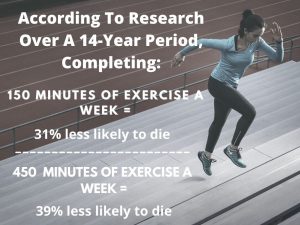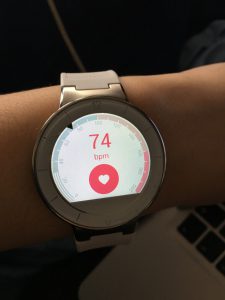Have you been getting in your recommended dose of exercise these days? Or are you feeling a little too sedentary and are ready to start moving? Either way, that’s great! The newest guidelines from the World Health Organization recommend 150 – 300 minutes of moderate-intensity exercise per week, or 75 – 150 minutes of vigorous-intensity exercise per week, so we should all be aiming for that to keep us at optimal health. But hang on – moderate? Vigorous? What does that mean, and which is better? And what about low intensity? Is that type of exercise right/beneficial for some? It sounds like a lot to think about when planning your daily exercise routine, but knowing the benefits, disadvantages, and risks of each exercise intensity level can help you get the most from the time you spend moving your body.
The Benefits of Exercise

Before we get into the different types of exercise, let’s start off by saying that physical activity of any kind is beneficial. And that’s not just opinion, there is a lot of scientific evidence to back it up. For example, in a JAMA Internal Medicine study, researchers pooled data from six studies and found that over a 14-year period, people who never exercised were at the highest risk of death. If that sounds scary, there’s hope that you can easily turn things around: those who did just a little exercise lowered their risk of death by 20%.
Not only that, but adding a little extra workout time was even more beneficial. People who completed at least 150 minutes per week of moderate exercise – the lowest WHO recommended amount – were 31% less likely to die than inactive people during the 14-year follow-up period. But those who kicked it up to at least 450 minutes of moderate exercise each week were 39% less likely to die.
Add to these statistics the many other benefits of exercise, like a healthier heart, stronger bones, and improved mood, and it becomes pretty clear that moving your body is the way to go. But just how should you be moving your body?
How Intense Is Your Workout?

Let’s first look at what intensity level means when it comes to exercise. There are generally two different ways to determine the intensity level of your workout. The first, and easier, of the two is the “talk test,” which basically means you’re measuring how hard you’re working out by how hard it is for you to carry on a conversation. According to Dr. Meagan Wasfy of the cardiovascular performance program at Harvard-affiliated Massachusetts General Hospital, “With low-intensity activities, most people will still be able to sing and converse. At moderate intensity, you can still speak but can’t sing, and at high intensity, you can’t speak in full sentences anymore.” Although, who wants to carry on a conversation in the middle of burpees?!
The other way to determine how hard you are working is a little more technical. You’ll need to measure your heart rate, which you can do with a heart rate monitor (many smartwatches have this function), or with a little simple math. Just find your pulse on your wrist or neck and count the number of beats for 10 seconds, and then multiply that number by six for beats per minute (BPM).
The next step is to do a little more math (sorry!), and determine your maximum heart rate (MHR) so you know how hard you should be working for each type of exercise. All you need to do to determine that is to subtract your age from 220. So, for example, if you’re 40, your maximum heart rate, or the absolute highest rate of intensity you should be achieving, is 180 BPM.
So let’s take a closer look at what it means for exercise to be low, moderate, and high intensity, and what you should be shooting for.
Low-Intensity Exercise
There is actually a technical way to determine how intense your exercise is: it’s calculated as a percentage of your maximum heart rate while you’re working out. That means more math! For low-intensity workouts, your heart rate will be at 30-50% of your maximum heart rate (MHR). So to go back to the example of a 40-year-old, you would take 180 (your MHR) and multiple it by 0.30 or 0.50 to get a target heart rate of 54-90 BPM.  In addition to that scientific way of classifying high-intensity exercise, you can also think about the types of movements you’re doing. Low-intensity workouts are also sometimes described as “low impact,” meaning you generally aren’t taking both feet off the ground at the same time. Movements tend to be more fluid, as opposed to jarring, and can include things like lighter yoga, low-resistance cycling, leisurely swimming, and casual walking.
In addition to that scientific way of classifying high-intensity exercise, you can also think about the types of movements you’re doing. Low-intensity workouts are also sometimes described as “low impact,” meaning you generally aren’t taking both feet off the ground at the same time. Movements tend to be more fluid, as opposed to jarring, and can include things like lighter yoga, low-resistance cycling, leisurely swimming, and casual walking.
Who low-intensity exercise is right for: This type of exercise is great for beginners or even those who think they can’t exercise because of chronic pain; in fact, a review published in the Cochrane Database of Systematic Reviews points out that aerobic exercise improved the quality of life for those in chronic pain by improving physical function and reducing stiffness and fatigue. Low-intensity workouts can also be used as a way for more advanced exercises to recover from injury, as a way to focus on balance and flexibility, as a way to recover from other workouts on days off, or as a way to boost your aerobic capacity so you can do other things for longer.
It carries very little risk of injury, making it a safe option for anyone; according to Ben Walker, a personal trainer and owner of Anywhere Fitness in Dublin, Ireland, “Low-intensity exercise reduces the risk of injury while preparing your body for more intense activities.” You might be surprised to know that low-intensity workouts actually primarily burn fat cells as a fuel source, so there’s lots of reasons why they’re a good place to start on your workout journey.
The disadvantages: While any type of movement is great, especially when you’re just starting out with a workout regime, low-intensity exercise didn’t have the same dramatic health effects as even moderate-intensity exercises, according to the studies we looked above. In addition, if you’re only doing these types of workouts, you might boost your heart health, but actually do the opposite for your muscle tissue. So, while low intensity is a great place to start on getting moving and burning excess fat, you don’t want to remain stagnant at this level of exercise; you should try to progress to more taxing workouts at some point if you are able.
Moderate-Intensity Exercise
The next level of intensity would be considered “moderate,” when you are working at 50-70% of your MHR. That means kicking things up a notch: walking more vigorously, taking a more intense hike, playing tennis, or doing some aerobic dancing, for example. You’re still generally not taking both feet off the ground at once, but your heart is definitely pumping more than it would be during a fully low-impact workout. The benefits: Bumping up your heart rate to that moderate range comes with a lot of advantages over low-intensity exercise. Not only will those longer, more intense workouts help you reap all of the benefits of the studies above, but you’ll switch from using just fat cells when working out to burning off fat, carbohydrates, and sugar. So if weight loss is your goal, you’ll get there faster by working out in this range.
The benefits: Bumping up your heart rate to that moderate range comes with a lot of advantages over low-intensity exercise. Not only will those longer, more intense workouts help you reap all of the benefits of the studies above, but you’ll switch from using just fat cells when working out to burning off fat, carbohydrates, and sugar. So if weight loss is your goal, you’ll get there faster by working out in this range.
The disadvantages: There’s not much negative to say about moderate-level exercise, except that it carries a higher risk of injury than low-intensity workouts, and that it will not give you the same muscle-building, strengthening, and body-fat-lowering results that high-intensity workouts will.
If your goal is to just to lose a few extra pounds or get in your recommended dose of heart-healthy exercise time, and moderate-intensity workouts are what you enjoy most, then go for it! But you might find at some point that you’re ready to progress to working to your full potential by adding in some high-intensity workouts.
High-Intensity (or Vigorous-Intensity) Exercise
For high-intensity exercise, you should be working out at 75-100% of your maximum heart rate (remember how you shouldn’t be able to carry on a conversation?), so that means you’re going to be doing some serious work. In many cases, you’ll be doing movements that require taking both feet off the ground, like running, jumping rope, or doing any kind of high-intensity interval training (HIIT) workout, with or without weights.  The benefits: Working out this hard means you’re going to get the best results when it comes to fat loss and muscle building. You’ll also boost your metabolism for hours after your high-intensity workout! In addition, research shows that high-impact exercises such as sprinting are also beneficial for the health of your bones: it might sound slightly surprising, but applying stress to your bones actually helps improve bone density. Again according to Ben Walker, “By training at maximum capacity, you increase potential for muscle growth and weight loss by breaking down more muscle fibers.”
The benefits: Working out this hard means you’re going to get the best results when it comes to fat loss and muscle building. You’ll also boost your metabolism for hours after your high-intensity workout! In addition, research shows that high-impact exercises such as sprinting are also beneficial for the health of your bones: it might sound slightly surprising, but applying stress to your bones actually helps improve bone density. Again according to Ben Walker, “By training at maximum capacity, you increase potential for muscle growth and weight loss by breaking down more muscle fibers.”
The disadvantages: High-intensity exercise is great, but it can be taxing on your body, and for many people, should be limited to 3 or 4 days a week. It carries a much higher risk of injury; after all, high-impact movements create a force equal to about 2.5 times your bodyweight, which can put a lot of stress on your joints, ligaments and tendons. If you’ve got joint problems, like arthritis, you should probably stick to more moderate, less high-impact movements.
So what’s right for you? Well, first talk to your doctor. Then, assess your current fitness level and always start out slow if you’re new to any kind of exercise. Choose your intensity level based on your goals, whether that is weight loss, gaining muscle, improving flexibility, training for a specific sport, or just boosting your heart health. But, when it comes down to it, any type of movement is great for your body and mind, so get out there and do what you enjoy!